What is a horn?
Hello, I’m Araki Jakkan, an ex-soundman writer. Previously, I had written an article called "[Sound Tips] A story about how to make good use of the SHURE SM58 standard microphone in the field of sound."
As the title says, this time I will write about horns.
I call it a "trumpet" in Japanese, but it may be more common to call it a "horn speaker" or a "trumpet speaker". But call it as you like. It is best for humans to do whatever they want.
In this article, I will refer to it as "trumpet" because this is easier for me.
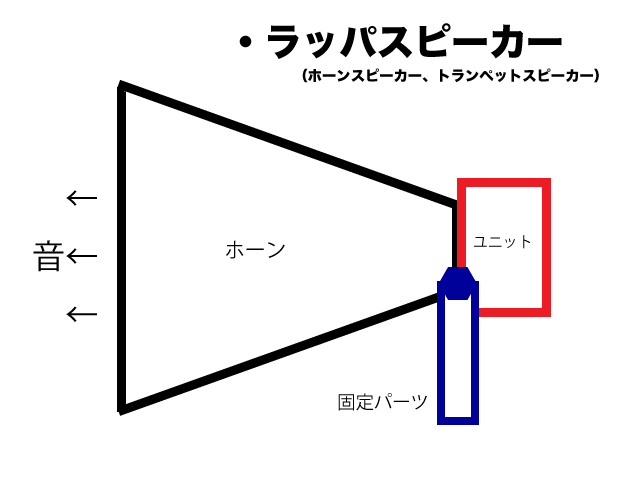
It looks like this.
You often see it as a speaker attached to a car.
A car from the city hall or a car selling roasted sweet potatoes. Others include election cars.
At schools, it is sometimes used for on-campus broadcasting.
Handheld loudspeakers and megaphones are also included.
Speaking of the best feature, they are drip-proof.
You don't have to worry about it getting damaged when it rains a little.
And even if it rains a little, there is a great possibility that it will be possible to use it for a long time if you keep a few tips in mind. Stay tuned for tips later in this article.
How the trumpet works
As shown in the figure above, the trumpet is roughly divided into a "horn" part and a "unit" part.
The wide part is the horn, and the mechanical parts attached to the bottom are the unit.
Depending on the item (because the outer frame is firmly fixed), the part where the horn and the unit are connected is made like a large screw hole.
So you can easily separate it by twisting it.
And, as you can see when they are separated, the horn is really just a cylinder.
Conversely, the unit is heavy. The coil is stuffed inside.
In other words, the unit is a speaker. Therefore, with the horn removed, the unit alone produces sound.
The reason why the horn is attached is to give the sound directivity. Because there is a horn, the sound flies forwards.
In addition, the horn is also useful for its drip-proof properties as I wrote earlier. It acts just like a roof.
There is a hole in the part where the sound of the unit comes out, but of course it is a machine, so if water drops enter from there, it will short-circuit and get damaged or rust.
The horn protects the unit.
Horns are excellent. It is like a knight who protects his princess by putting himself in harms’ way using his body.
"W?" "Ω?" "Parallel connection?" A rough explanation of technical terms
I am getting derailed here, as this is not related to the trumpet, please allow me to insert a glossary of acoustic terms.
For example, have you ever come across the words "W (watt)", "Ω (ohm)" and "parallel connection" when choosing a home speaker?
If you're involved in sound, you'll most likely see it, especially if you're considering buying equipment. On the contrary, if you want get involved in sound, you have to understand this to some extent before you buy the equipment. If not, the equipment will break. The sound also gets worse.
So, I thought I'd explain these technical terms within my knowledge, but the explanation of the three terms listed above would be extremely long. The scroll bar would become the size of a grain of rice.
So, in writing this, I took a questionnaire on Twitter, "Which technical terms are the most incomprehensible?" The results is here.
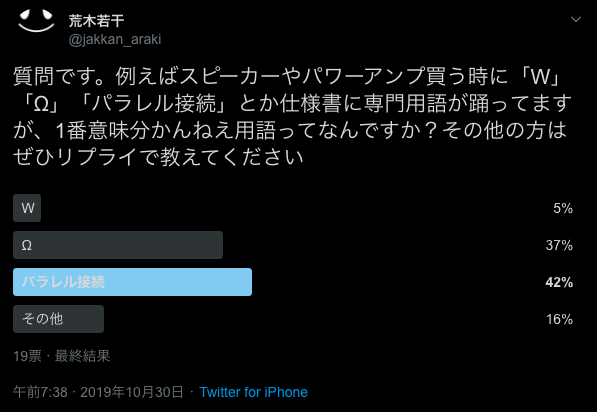
https://twitter.com/jakkan_araki/status/1189310578986291200
Thank you to those who answered the questionnaire. I also saw a tweet saying "I don't know all the parts", so I'll send a long commentary DM to that person next time.
So, I will write about "parallel connection" according to the results of the questionnaire.
What is a "parallel connection"?
When you hear "parallel", you want to add "world".
Speaking of "parallel", do you remember your elementary school science class?
There was an experiment using two batteries that makes a miniature bulb shine by "series connection" and "parallel connection".
The results of the experiment aside, and the important thing is the connection, saying that the series connection shines brighter and the parallel connection provides a longer battery life.
In a series connection, the wires are connected in the order of plus, minus, plus, minus.
On the other hand, in a parallel connection, plus is connected with plus, and minus is connected with minus.
That’s right! That’s a parallel connection! That is the "parallel connection" that we have been pursuing!
Why a “parallel connection”?
Let's return to the trumpet article here.
The trumpet makes a sound by connecting the two plus and minus wires.
However, for example, when using a trumpet as a speaker for an election car, you want to make sound in all directions around the car. In that case, you will have to use multiple trumpets.
That's where parallel connections come in.
In fact, the trumpet produces sound even when connected in series.
If you use two trumpets, you can connect them like this.
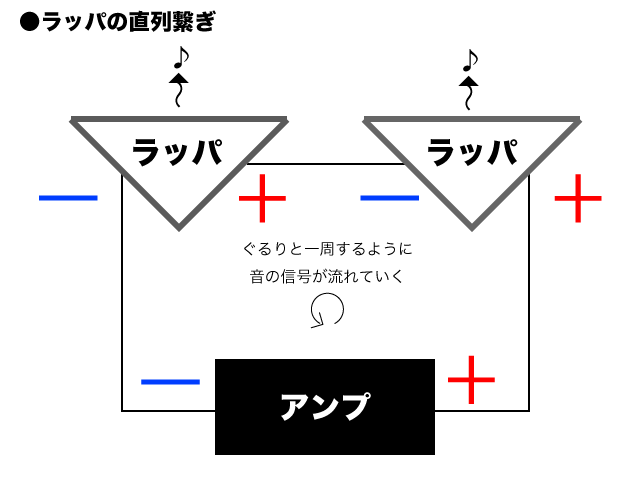
As shown in the figure, in the case of series connection, the sound signal flows from plus to minus.
By the way, what kind of connection is used for parallel connections?
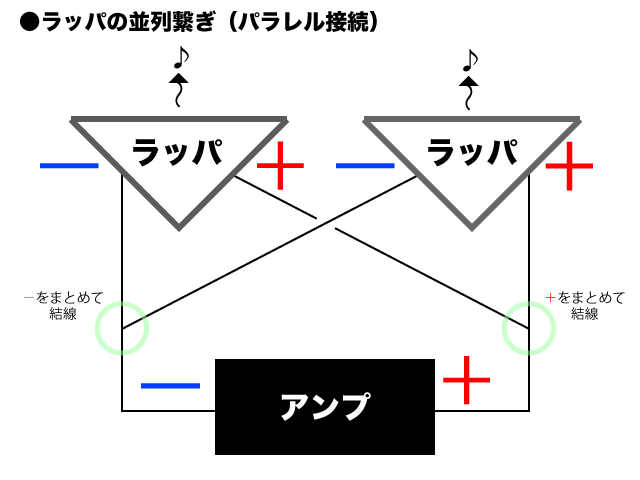
It will look like this. For the time being, all the same poles should be put together.
Now, why do you connect in parallel?
That is because the same sound is output from multiple speakers.
As I wrote earlier, sound can be produced even by connecting in series.
However, in fact, the sound changes with the first trumpet connected from the amplifier and the second trumpet connected from there.
I'm sorry I don't know what will happen ... Please check it out for yourself and let us know later. I'll be waiting for you on Twitter DM.
However, I would like to tell you about the changes in the sound that I made in the past when I accidentally connected them in series.
-The volume of the second trumpet is lower than that of the first one. Less than half.
-Although the volume is low, the sound breaks up. Crackly. Radio condition with poor radio waves.
The above phenomenon occurred.
In my mind, I think of it as "when connected in series, the first speaker has power, and the power that flows into the second speaker is insufficient."
A parallel connection avoids this. With this connection method, "Since equal power can be sent to multiple speakers, the same sound is output from each."
I hope this explanation gives you a little idea of what "parallel connection" is, but what about it?
In detail, the two wires extending from the amplifier may be "L" and "R" instead of plus and minus, and the speaker alone can output in parallel (the speaker has a parallel connection function inside). There are a lot of things I’m not explaining in detail, such as having to think about the "Ω" mentioned above.
However, if you focus on one point of a parallel connection, it looks like this.
I hope you can roughly understand it.
By the way, in this explanation, I thought that it would be easy to understand because they’re words that I often hear, so I wrote "plus" for "+" and "minus" for "-". "+"is called "hot" and "-" is called "cold".
So, if you are thinking of starting doing sound from now, let's make talk about it as "A parallel connection is hot to hot, cold to cold...". You can start to feel like sound man. It's fun to get a feel for it first.
Tips for installing a trumpet on your car
Finally, I would like to introduce some tips for installing the trumpet on a car.
In fact, it's better to do this in any situation when using the trumpet outdoors.
If you drive a car when it's raining, the raindrops will hit the car from the front.
If you attach the trumpet to the car without thinking about it, it will look like this.
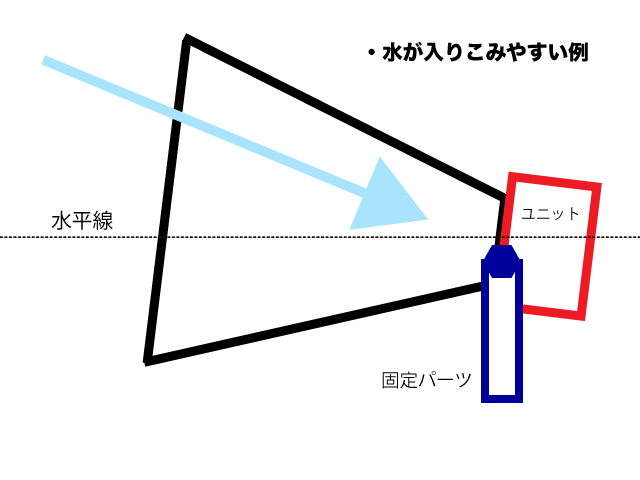
For some reason, you’ll want the trumpet to be parallel to or slightly upward from the horizon. That’s how it’s shaped.
However, if you do so, when it rains, the possibility of raindrops reaching the unit inside will increase dramatically. If that happens, of course it will get damaged. All that money. What a waste.
Furthermore, if it’s facing upward, even a small drop of water will travel down the top of the horn and penetrate all the way in.
So let's do this.
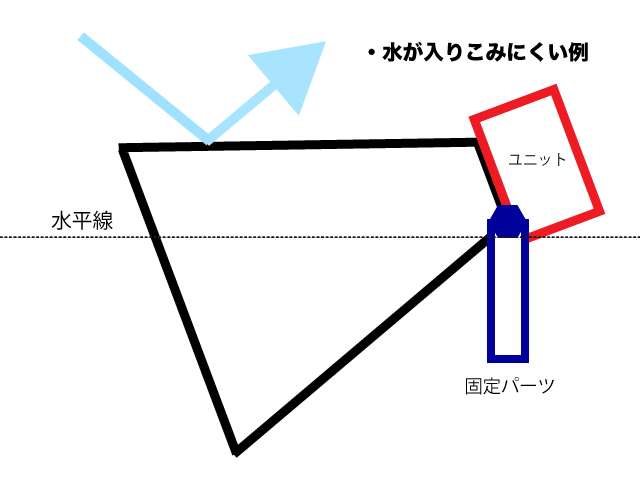
The figure is drawn roughly, but if you make the angle so that the upper part of the horn and the horizon are parallel, it will be stronger against blowing water drops because there is no angle.
Most of the parts are installed with nuts and bolts, so you can change the angle with just a wrench.
Of course, the horn points downwards so the sound may not travel as far, but honestly it's a minor difference. Instead, protect your wallet.
I've talked about it so far, but if you ask at a car shop, they may install it for you (when installing the amplifier for the speaker, it may be necessary to get the power supply using the car battery, which may be difficult for an amateur, (I'm also afraid of electric shock). This was for a small niche of people who want to use the trumpet speaker personally.
This has gotten long. That's all for the trumpet. I hope to see you again at the next opportunity.


























